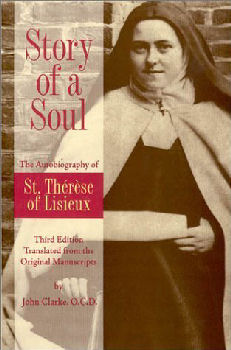
|
Posted February 28, 2006
An Excellent Book For Lent!!! Book: St. Therese of Lisieux: Story of a Soul Translation by John Clarke, O.C.D. Prepared by Marc Foley, O.C.D. ICS Publications, Washington, D.C., 2005, pp. 459 An Excerpt from the Jacket:
Father John Clarke’s acclaimed translation, first published in 1975 and now accepted as the standard throughout the English-speaking world, is a faithful and unaffected rendering of Therese’s own words from the original manuscripts. This study edition is designed to assist contemporary readers to apply the spiritual insights of Story of a Soul to their lives. It provides introductions, reflections and discussion questions for each chapter of the text. An Excerpt from the Book: “I have frequently noticed,’ Therese confided to me, [wrote Celine], ‘that after I have committed a fault, even a slight one, my soul experiences certain sadness or uneasiness for some little time. Then I tell myself, “Now little one, this is the price you must pay for your fault, and so I patiently bear with the trial until the little debt is paid.’ According to Theresa’s understanding of the virtue of hope, that was the extent of satisfaction required by Divine Justice for those who are humble and who abandon themselves to God in love. She could not believe such souls would have to go to Purgatory. She thought, rather, that at the moment of death their Father in heaven, because of their confidence, would kindle in their souls as they realized their misery an attitude of perfect contrition, and that in this way their entire debt should be cancelled.” In short, Therese is saying, that by patiently bearing the pain that follows in the wake of committing some fault or failing, we are confiding ourselves to the mercy of God and it is by the mercy of God alone that we are purified. Therese gives us an example of how we are to confide ourselves to the mercy of God in her image of the “weak little bird,” who after committing “misdeeds, instead of going and hiding away in a corner, to week over its misery and to die of sorrow. . .turns towards its beloved Sun, presenting its wet wings to its beneficent rays. . .recounts in detail all its infidelities, thinking in boldness of its full trust that it will acquire in even greater fullness the love of Him who came to call not the just but sinners.” What Therese is proposing is more difficult than it seems, for when we are filled with guilt and a sense of our own wretchedness, it is hard to believe in the mercy of God, for guilt tends to project upon the face of God a stern grimace. Our sins do not alter God’s merciful love toward us; they simply make it more difficult for us to believe in it. Julian of Norwich writes that there is no wrath in God. “God is that goodness which cannot be angry, for God is nothing but goodness.” Commenting upon this passage, Robert Llewelyn writes: “God’s face of compassionate love is always turned towards us, and if what we see in God is wrath, that is because of a corruption within ourselvs which we have projected on to God, for our tendency is always to make God in our own image . . . Moreover we are not to be surprised, nor depressed, nor discouraged by occasions of falling, for what at least is certain is that we can never fall outside of God’s love. Our falling, Julian might well have said, is not so much a falling into sin as falling into the arms of God’s mercy. In Francis Thompson’s poem The Hound of Heaven, Thompson images God as a vicious hound that is pursuing him, but at the end of the poem when God finally corners him, Thompson realizes that he has been mistaken. What he interpreted as the menacing shadow of God’s wrath is revealed as the refreshing shade of God’s mercy; what he thought was God’s hand poised to strike him was in truth God’s hand reaching out to caress him. “Is my gloom, after all, Shade of His hand, outstretched caressingly?” Our sins can make us feel that we are beyond the reach of God’s mercy. Therese believed just the opposite. “I feel that even though I had on my conscience all the sins that can be committed, I would go, my heart broken with sorrow, and throw myself into Jesus’ arms, for I know how much He loves the prodigal child who returns to Him. The prodigal son returned home to his father’s house not for any noble motive but because he was hungry and down on his luck. Nevertheless, his father welcomed him home with open arms, without reproach. This is the image of God that Jesus reveals to us and we are invited to believe. But how difficult it is to believe in God’s mercy when we have squandered our inheritance and feel that we no longer deserve to be called God’s child. How difficult it is at these times not to give in to the temptation to run away and hide “in a corner, to weep over [one’s] misery and to die of sorrow”. What strength it takes to be like the little weak bird and present the wet wings of our soul to the Sun of God’s mercy. Table of Contents: 1. Alencon [1873-1877] 2. Les Buissonnets [1877-1881] 3. The Distressing Years [1881-83] 4. First Communion, Boarding School [83-86] 5. After the Grace of Christmas [86-87] 6. The Trip to Rome [87] 7. The First Years in Carmel [88-90] 8. Profession and Offering to Merciful Love [90-95] 9. My Vocation is Love [96] 10. The Trial of Faith [96-97] 11. Those Whom You Have Given Me [96-97] Epilogue |
|
